Propagation of Cryogenic Thermal Fractures from Unconfined PMMA Boreholes
Abstract
:1. Introduction
2. Laboratory Study
2.1. Devices and Procedure
2.2. Specimens
3. Results and Discussions
3.1. Temperature, Pressure, and LN Usage
3.2. Fracture Propagation
3.3. Exclusion Distance
3.4. Fracture Curvature and Interaction between Fractures
3.5. Striation in Fractures
3.6. LN in Crack Aperture on the Propagation of Fracture and Temperature
3.7. Effect of Casing
4. Limitations
5. Conclusions
Author Contributions
Funding
Institutional Review Board Statement
Informed Consent Statement
Data Availability Statement
Conflicts of Interest
References
- Huang, Z.; Zhang, S.; Yang, R.; Wu, X.; Li, R.; Zhang, H.; Hung, P. A review of liquid nitrogen fracturing technology. Fuel 2020, 266, 117040. [Google Scholar] [CrossRef]
- Wu, X.; Huang, Z.; Li, R.; Zhang, S.; Wen, H.; Huang, P.; Dai, X.; Zhang, C. Investigation on the damage of high-temperature shale subjected to liquid nitrogen cooling. J. Nat. Gas. Sci. Eng. 2018, 57, 284–294. [Google Scholar] [CrossRef]
- Han, S.; Cheng, Y.; Gao, Q.; Yan, C.; Han, Z. Experimental study of the effect of liquid nitrogen pretreatment on shale fracability. J. Nat. Gas. Sci. Eng. 2018, 60, 11–23. [Google Scholar] [CrossRef]
- Cai, C.; Li, G.; Huang, Z.; Shen, Z.; Tian, S.; Wei, J. Experimental study of the effect of liquid nitrogen cooling on rock pore structure. J. Nat. Gas. Sci. Eng. 2014, 21, 507–517. [Google Scholar] [CrossRef]
- Alqatahni, N.B.; Cha, M.; Yao, B.; Yin, X.; Kneafsey, T.J.; Wang, L.; Wu, Y.-S.; Miskimins, J.L. Experimental Investigation of Cryogenic Fracturing of Rock Specimens Under True Triaxial Confining Stresses. In Proceedings of the SPE Europec Featured at 78th EAGE Conference and Exhibition, Vienna, Austria, 20 May 2016; p. 24. Available online: https://onepetro.org/SPEEURO/proceedings-abstract/16EURO/All-16EURO/SPE-180071-MS/186639 (accessed on 30 May 2021).
- Elwegaa, K.; Emadi, H. The effect of thermal shocking with nitrogen gas on the porosities, permeabilities, and rock mechanical properties of unconventional reservoirs. Energies 2018, 11, 2131. [Google Scholar] [CrossRef] [Green Version]
- Du, M.; Gao, F.; Cai, C.; Su, S.; Wang, Z. Study on the surface crack propagation mechanism of coal and sandstone subjected to cryogenic cooling with liquid nitrogen. J. Nat. Gas. Sci. Eng. 2020, 81, 103436. [Google Scholar] [CrossRef]
- Cha, M.; Yin, X.; Kneafsey, T.; Johanson, B.; Alqahtani, N.; Miskimins, J.; Patterson, T.; Wu, Y.-S. Cryogenic fracturing for reservoir stimulation—Laboratory studies. J. Pet. Sci. Eng. 2014, 124, 436–450. [Google Scholar] [CrossRef] [Green Version]
- Li, R.; Huang, Z.; Wu, X.; Yan, P.; Dai, X. Cryogenic quenching of rock using liquid nitrogen as a coolant: Investigation of surface effects. Int. J. Heat Mass Transf. 2018, 119, 446–459. [Google Scholar] [CrossRef]
- Tang, S.; Wang, J.; Chen, P. Theoretical and numerical studies of cryogenic fracturing induced by thermal shock for reservoir stimulation. Int. J. Rock Mech. Min. Sci. 2020, 125, 104160. [Google Scholar] [CrossRef]
- Yang, R.; Chunyang, H.; Huang, Z.; Wen, H.; Li, X.; Huang, P.; Liu, W.; Chen, J. Liquid Nitrogen Fracturing in Boreholes under True Triaxial Stresses: Laboratory Investigation on Fractures Initiation and Morphology. SPE J. 2020, 26, 135–154. [Google Scholar] [CrossRef]
- Yao, B.; Wang, L.; Yin, X.; Wu, Y.-S. Numerical modeling of cryogenic fracturing process on laboratory-scale Niobrara shale samples. J. Nat. Gas. Sci. Eng. 2017, 48, 169–177. [Google Scholar] [CrossRef]
- Gao, F.; Cai, C.; Yang, Y. Experimental research on rock fracture failure characteristics under liquid nitrogen cooling conditions. Results Phys. 2018, 9, 252–262. [Google Scholar] [CrossRef]
- Jiang, L.; Cheng, Y.; Han, Z.; Gao, Q.; Yan, C.; Wang, H.; Fu, L. Effect of liquid nitrogen cooling on the permeability and mechanical characteristics of anisotropic shale. J. Pet. Explor. Prod. Technol. 2019, 9, 111–124. [Google Scholar] [CrossRef] [Green Version]
- Cha, M.; Alqahtani, N.B.; Yao, B.; Yin, X.; Kneafsey, T.J.; Wang, L.; Wu, Y.-S.; Miskimins, J.L. Cryogenic Fracturing of Wellbores Under True Triaxial-Confining Stresses: Experimental Investigation. SPE J. 2018, 23, 1271–1289. [Google Scholar] [CrossRef] [Green Version]
- Zhang, S.; Huang, Z.; Zhang, H.; Guo, Z.; Wu, X.; Wang, T.; Zhang, C.; Xiong, C. Experimental study of thermal-crack characteristics on hot dry rock impacted by liquid nitrogen jet. Geothermics 2018, 76, 253–260. [Google Scholar] [CrossRef]
- Wu, X.; Huang, Z.; Song, H.; Zhang, S.; Cheng, Z.; Li, R.; Wen, H.; Huang, P.; Dai, X. Variations of Physical and Mechanical Properties of Heated Granite After Rapid Cooling with Liquid Nitrogen. Rock Mech. Rock Eng. 2019, 52, 2123–2139. [Google Scholar] [CrossRef]
- Wu, X.; Huang, Z.; Cheng, Z.; Zhang, S.; Song, H.; Zhao, X. Effects of cyclic heating and LN2-cooling on the physical and mechanical properties of granite. Appl. Therm. Eng. 2019, 156, 99–110. [Google Scholar] [CrossRef]
- Zhang, S.; Huang, Z.; Huang, P.; Wu, X.; Xiong, C.; Zhang, C. Numerical and experimental analysis of hot dry rock fracturing stimulation with high-pressure abrasive liquid nitrogen jet. J. Pet. Sci. Eng. 2018, 163, 156–165. [Google Scholar] [CrossRef]
- Zhang, S.; Huang, Z.; Wang, H.; Li, G.; Sepehrnoori, K.; Wu, X.; Hong, C. Experimental study on the rock-breaking characteristics of abrasive liquid nitrogen jet for hot dry rock. J. Pet. Sci. Eng. 2019, 181, 106166. [Google Scholar] [CrossRef]
- Bourdin, B.; Marigo, J.-J.; Maurini, C.; Sicsic, P. Morphogenesis and Propagation of Complex Cracks Induced by Thermal Shocks. Phys. Rev. Lett. 2014, 112, 014301. [Google Scholar] [CrossRef] [Green Version]
- Jenkins, D.R. Determination of crack spacing and penetration due to shrinkage of a solidifying layer. Int. J. Solids Struct. 2009, 46, 1078–1084. [Google Scholar] [CrossRef] [Green Version]
- Jiang, C.P.; Wu, X.F.; Li, J.; Song, F.; Shao, Y.F.; Xu, X.H.; Yan, P. A study of the mechanism of formation and numerical simulations of crack patterns in ceramics subjected to thermal shock. Acta Mater. 2012, 60, 4540–4550. [Google Scholar] [CrossRef] [Green Version]
- Yang, R.; Huang, Z.; Shi, Y.; Yang, Z.; Huang, P. Laboratory investigation on cryogenic fracturing of hot dry rock under triaxial-confining stresses. Geothermics 2019, 79, 46–60. [Google Scholar] [CrossRef]
- Yang, R.; Hong, C.; Huang, Z.; Yang, Z.; Huang, P. An Experimental Investigation of Cyclic Cryogenic Fracturing in Coalbed Methane Reservoirs. In Proceedings of the 53rd U.S. Rock Mechanics/Geomechanics Symposium, New York, NY, USA, 28 August 2019; p. 8. Available online: https://onepetro.org/ARMAUSRMS/proceedings-abstract/ARMA19/All-ARMA19/ARMA-2019-1710/124954 (accessed on 30 May 2021).
- Zhang, H.; Huang, Z.; Zhang, S.; Yang, Z.; McLennan, J.D. Improving heat extraction performance of an enhanced geothermal system utilizing cryogenic fracturing. Geothermics 2020, 85, 101816. [Google Scholar] [CrossRef]
- de Borst, K.; Tan, C.P.; Mat Piah, M.F.; Groenenboom, J. First-Time Insights into Hydraulic Fracturing of Unconsolidated Sands from Novel Laboratory Experiments with in-situ CT-Scanning. In Proceedings of the International Petroleum Technology Conference, 23 March–1 April 2021. [Google Scholar]
- Huang, P.; Huang, Z.; Yang, Z.; Wu, X.; Li, R.; Zhang, S. An innovative experimental equipment for liquid nitrogen fracturing. Rev. Sci. Instrum. 2019, 90, 036104. [Google Scholar] [CrossRef] [PubMed]
- Qin, L.; Zhai, C.; Liu, S.; Xu, J. Mechanical behavior and fracture spatial propagation of coal injected with liquid nitrogen under triaxial stress applied for coalbed methane recovery. Eng. Geol. 2018, 233, 1–10. [Google Scholar] [CrossRef]
- Cha, M.; Alqahtani, N.B.; Yin, X.; Kneafsey, T.J.; Yao, B.; Wu, Y.-S. Laboratory system for studying cryogenic thermal rock fracturing for well stimulation. J. Pet. Sci. Eng. 2017, 156, 780–789. [Google Scholar] [CrossRef] [Green Version]
- Gan, Q.; Elsworth, D.; Alpern, J.S.; Marone, C.; Connolly, P. Breakdown pressures due to infiltration and exclusion in finite length boreholes. J. Pet. Sci. Eng. 2015, 127, 329–337. [Google Scholar] [CrossRef]
- Khadraoui, S.; Hachemi, M.; Allal, A.; Rabiei, M.; Arabi, A.; Khodja, M.; Lebouachera, S.E.I.; Drouiche, N. Numerical and experimental investigation of hydraulic fracture using the synthesized PMMA. Polym. Bull. 2020, 78, 3803–3820. [Google Scholar] [CrossRef]
- Alpern, J.; Marone, C.; Elsworth, D.; Belmonte, A.; Connelly, P. Exploring the Physicochemical Processes That Govern Hydraulic Fracture Through Laboratory Experiments. In Proceedings of the 46th U.S. Rock Mechanics/Geomechanics Symposium, Chicago, IL, USA, 1 January 2012; p. 6. Available online: https://onepetro.org/ARMAUSRMS/proceedings-abstract/ARMA12/All-ARMA12/ARMA-2012-678/120896 (accessed on 30 May 2021).
- Yu, P.; Yao, X.; Tan, S.; Han, Q. A Macro-Damaged Viscoelastoplastic Model for Thermomechanical and Rate-Dependent Behavior of Glassy Polymers. Macromol. Mater. Eng. 2016, 301, 469–485. [Google Scholar] [CrossRef]
- Richeton, J.; Ahzi, S.; Vecchio, K.S.; Jiang, F.C.; Adharapurapu, R.R. Influence of temperature and strain rate on the mechanical behavior of three amorphous polymers: Characterization and modeling of the compressive yield stress. Int. J. Solids Struct. 2006, 43, 2318–2335. [Google Scholar] [CrossRef] [Green Version]
- Abdel-Wahab, A.A.; Ataya, S.; Silberschmidt, V.V. Temperature-dependent mechanical behaviour of PMMA: Experimental analysis and modelling. Polym. Test. 2017, 58, 86–95. [Google Scholar] [CrossRef] [Green Version]
- Bilotti, E.; Fenwick, O.; Schroeder, B.C.; Baxendale, M.; Taroni-Junior, P.; Degousée, T.; Liu, Z. 6.14 Organic Thermoelectric Composites Materials. In Comprehensive Composite Materials II; Beaumont, P.W.R., Zweben, C.H., Eds.; Elsevier: Oxford, UK, 2018; pp. 408–430. Available online: https://www.sciencedirect.com/science/article/pii/B9780128035818100244?via%3Dihub (accessed on 30 May 2021).
- Esposito, M.; Buontempo, S.; Petriccione, A.; Zarrelli, M.; Breglio, G.; Saccomanno, A.; Szillasi, Z.; Makovec, A.; Cusano, A.; Chiuchiolo, A.; et al. Fiber Bragg Grating sensors to measure the coefficient of thermal expansion of polymers at cryogenic temperatures. Sens. Actuators A Phys. 2013, 189, 195–203. [Google Scholar] [CrossRef]
- Finn, T.M. Stratigraphic cross Sections of the Niobrara Interval of the Cody Shale and Associated Rocks in the Wind River Basin, Central Wyoming; U. S. Geological Survey: Reston, VA, USA, 2017; p. 3370.
- Zoback, M.D. Reservoir Geomechanics; Cambridge University Press, 2010. Available online: https://books.google.co.kr/books?hl=en&lr=&id=Xx63OaM2JIIC&oi=fnd&pg=PR7&dq=40.%09Zoback,+M.D.+Reservoir+Geomechanics%3B+Cambridge+University+Press:++2010.&ots=yuj9CYZaMT&sig=6YiFUgI6w31g9NgUSG9iIYtWRWQ&redir_esc=y#v=onepage&q=40.%09Zoback%2C%20M.D.%20Reservoir%20Geomechanics%3B%20Cambridge%20University%20Press%3A%20%202010.&f=false (accessed on 30 May 2021).
- Tarasovs, S.; Ghassemi, A. Self-similarity and scaling of thermal shock fractures. Phys. Rev. E 2014, 90, 012403. [Google Scholar] [CrossRef] [Green Version]
- Buijse, M.A. Understanding wormholing mechanisms can improve acid treatments in carbonate formations. SPE Prod. Facil. 2000, 15, 168–175. [Google Scholar] [CrossRef]
- Toramaru, A.; Matsumoto, T. Columnar joint morphology and cooling rate: A starch-water mixture experiment. J. Geophys. Res. Solid Earth 2004, 109, B02205. [Google Scholar] [CrossRef]
- Timm, D.; Guzina, B.B.; Voller, V.R. Prediction of thermal crack spacing. Int. J. Solids Struct. 2003, 40, 125–142. [Google Scholar] [CrossRef]
- Weijers, L. The Near-Wellbore Geometry of Hydraulic Fractures Initiated from Horizontal and Deviated Wells. Ph.D. Thesis, Delft University of Technology, Delft, The Netherlands, 1995. [Google Scholar]
- Weijermars, R.; Wang, J. Stress Reversals near Hydraulically Fractured Wells Explained with Linear Superposition Method (LSM). Energies 2021, 14, 3256. [Google Scholar] [CrossRef]
- Weijermars, R. Stress cages and fracture cages in stress trajectory models of wellbores: Implications for pressure management during drilling and hydraulic fracturing. J. Nat. Gas. Sci. Eng. 2016, 36, 986–1003. [Google Scholar] [CrossRef]


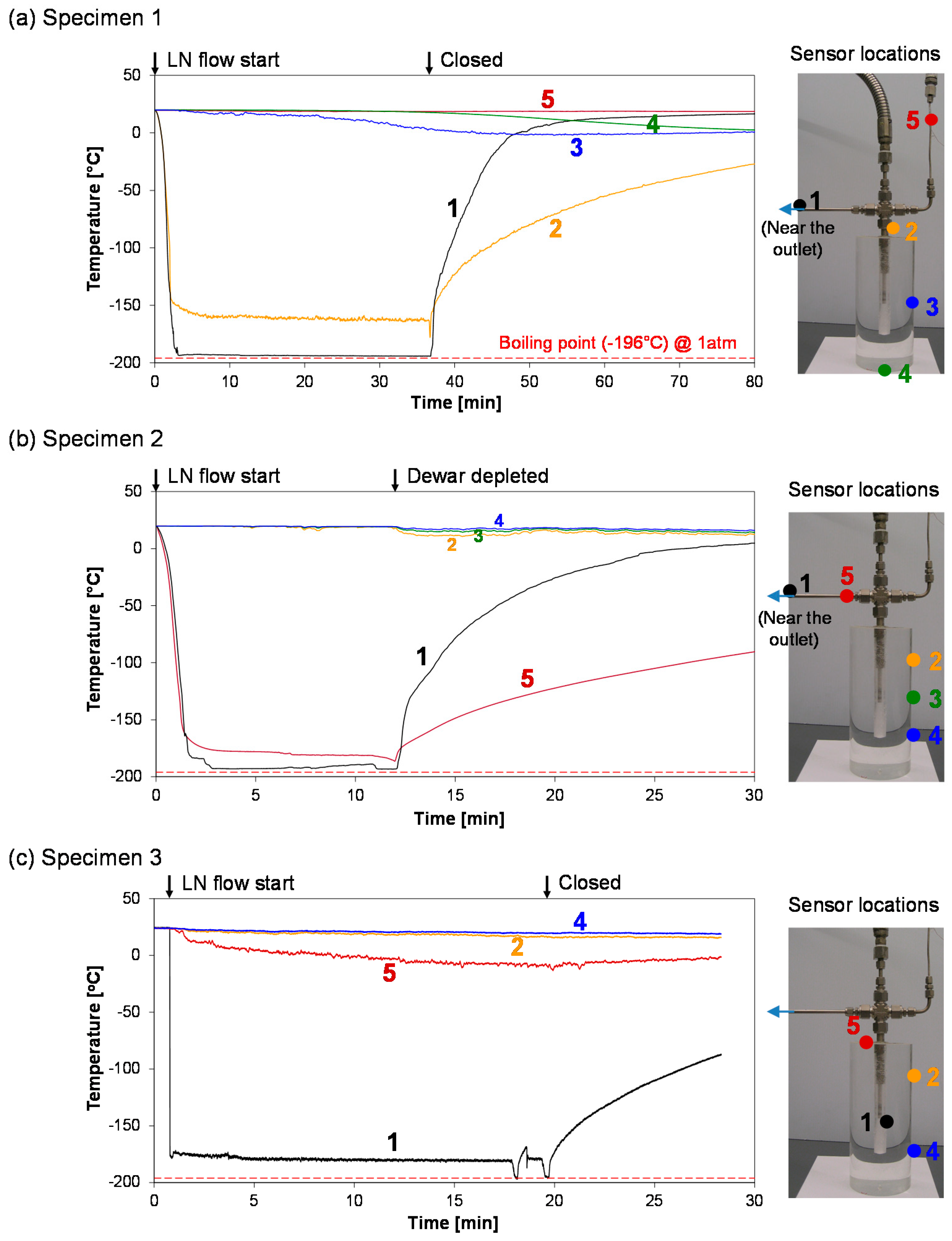

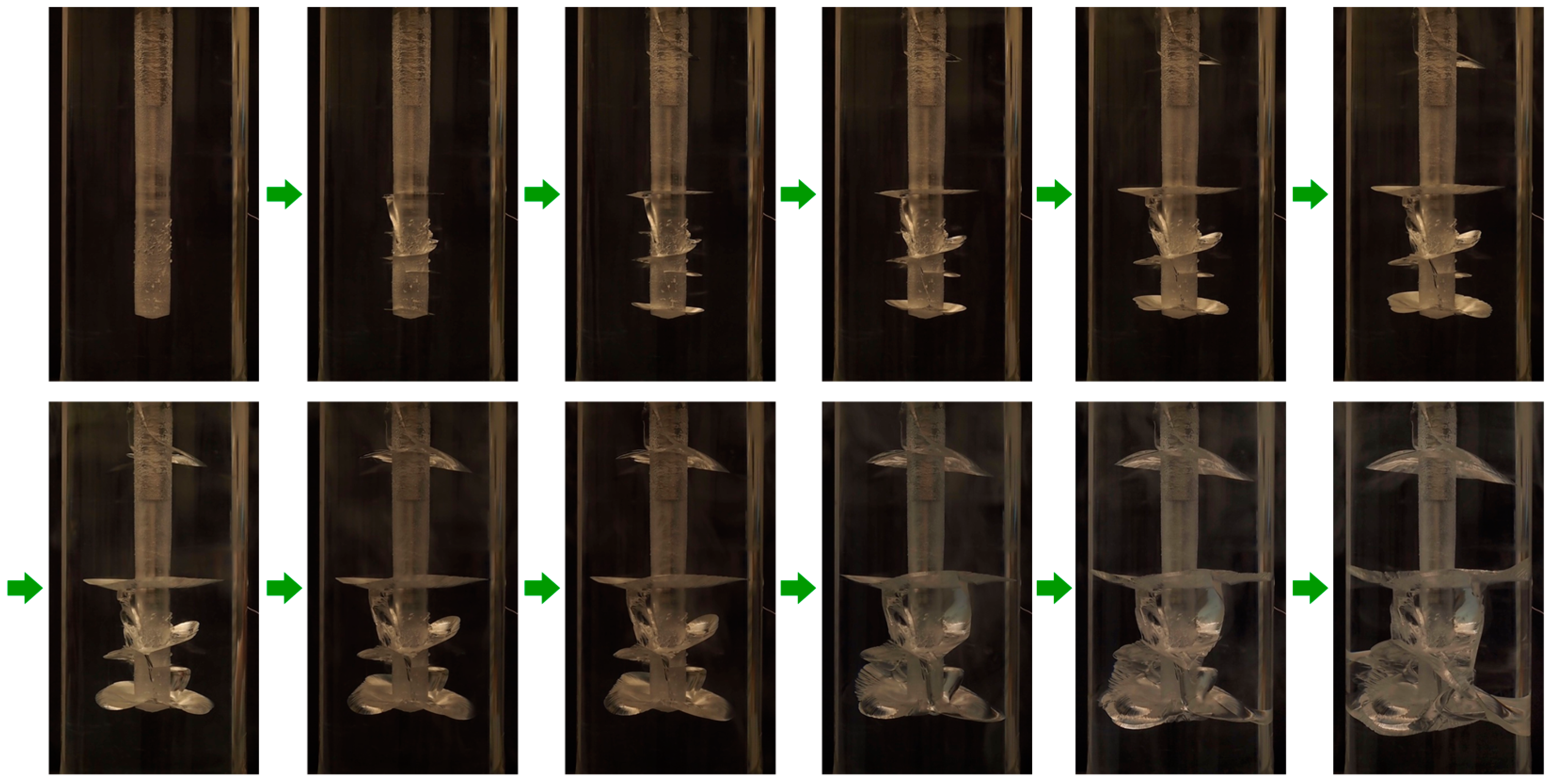

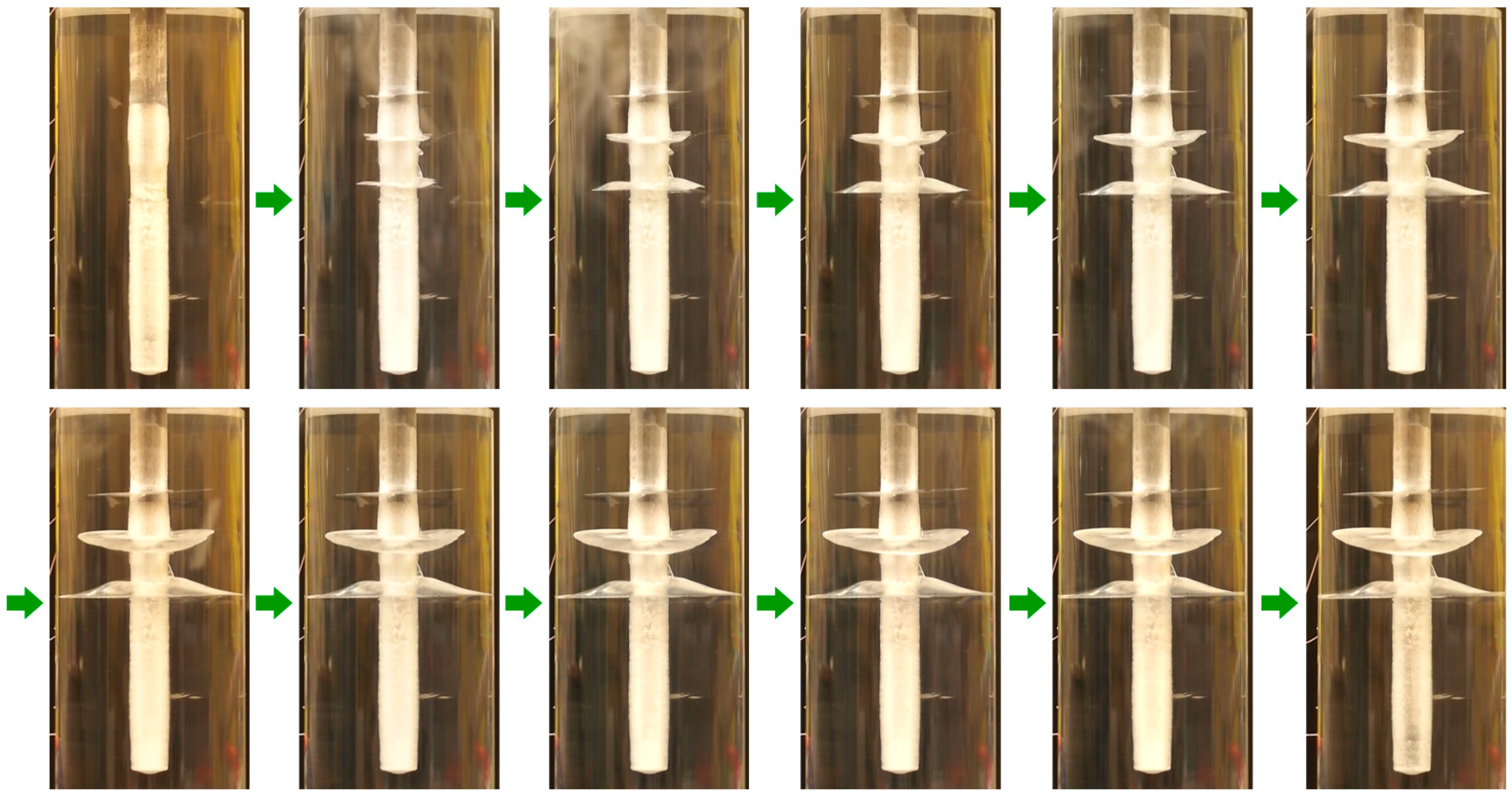
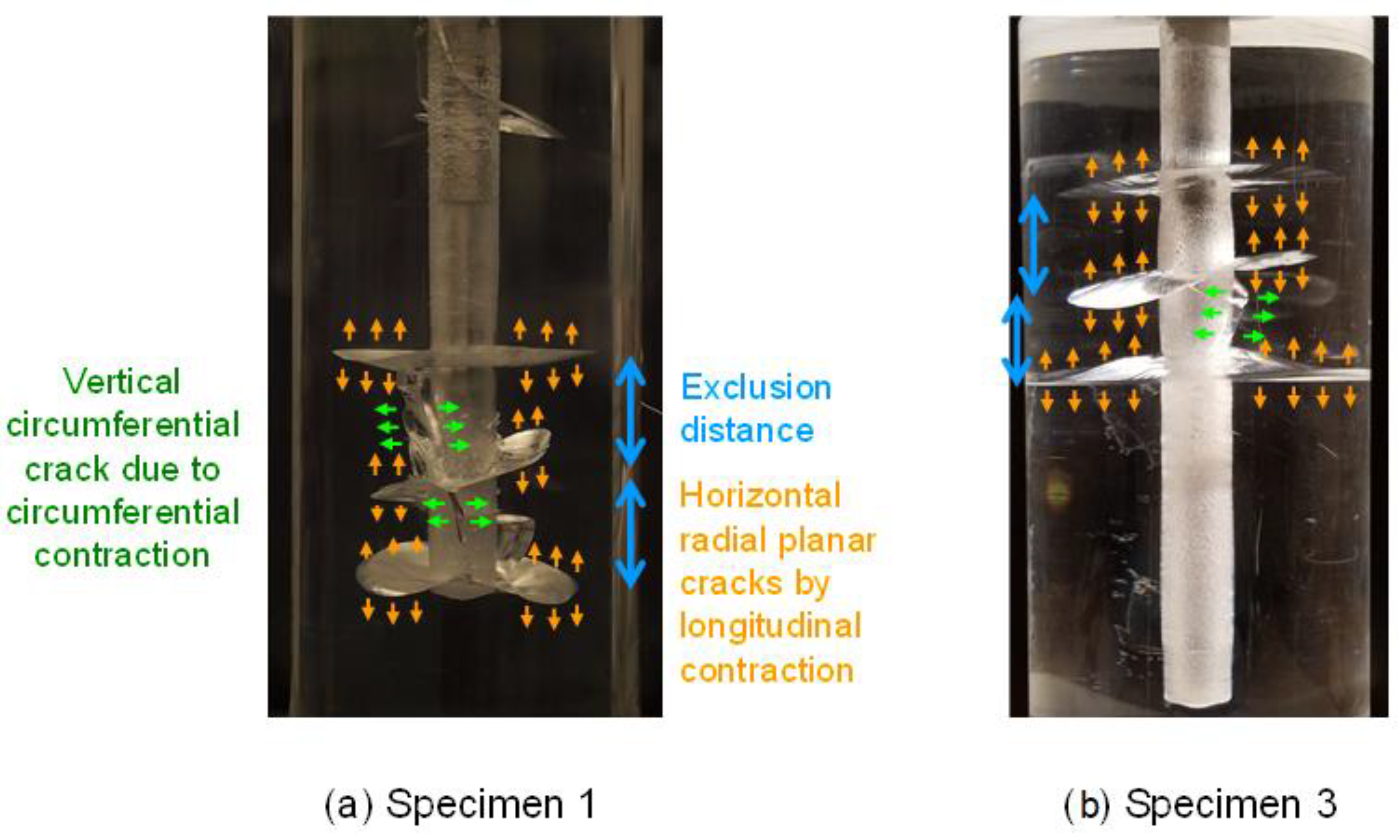

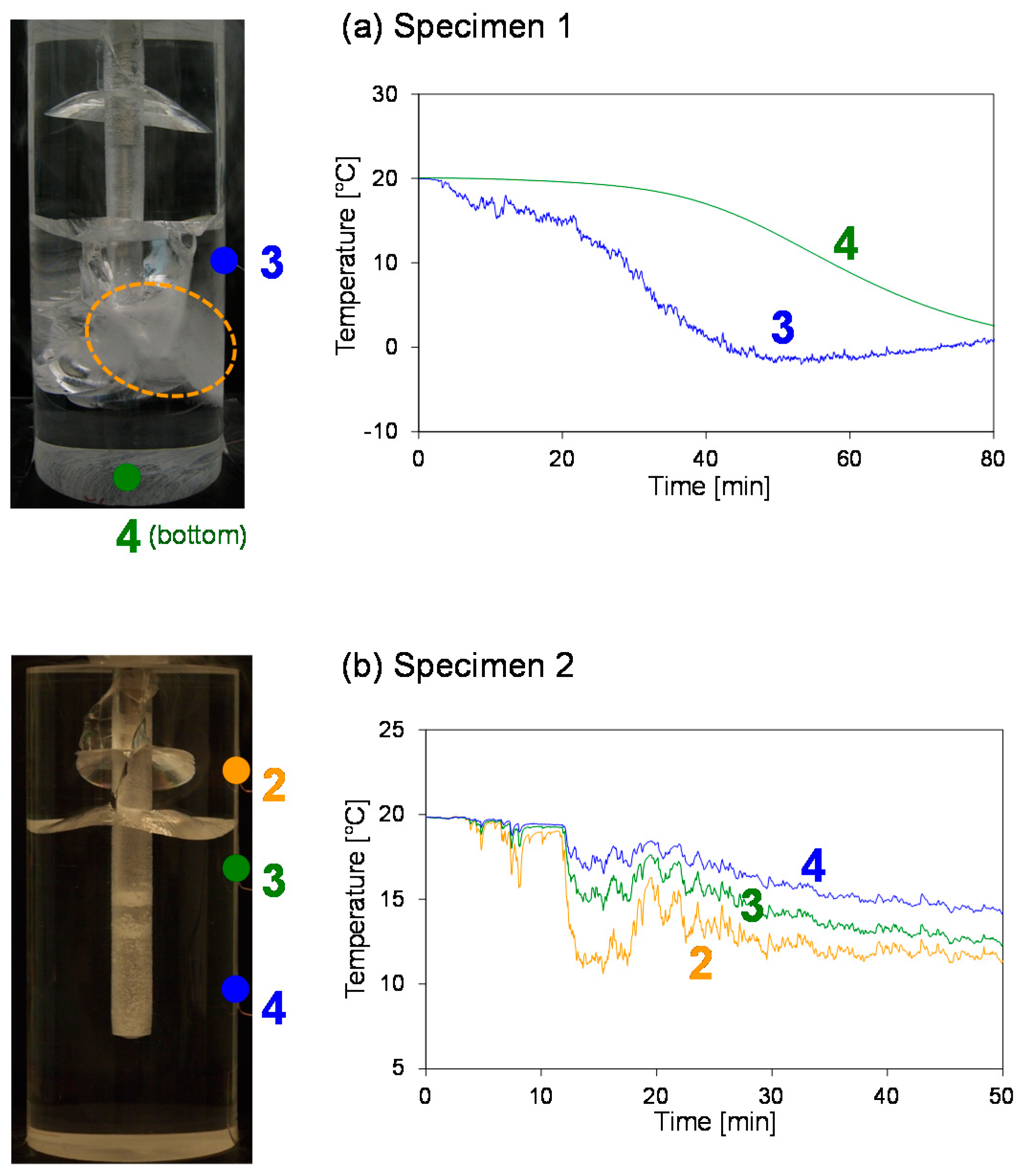
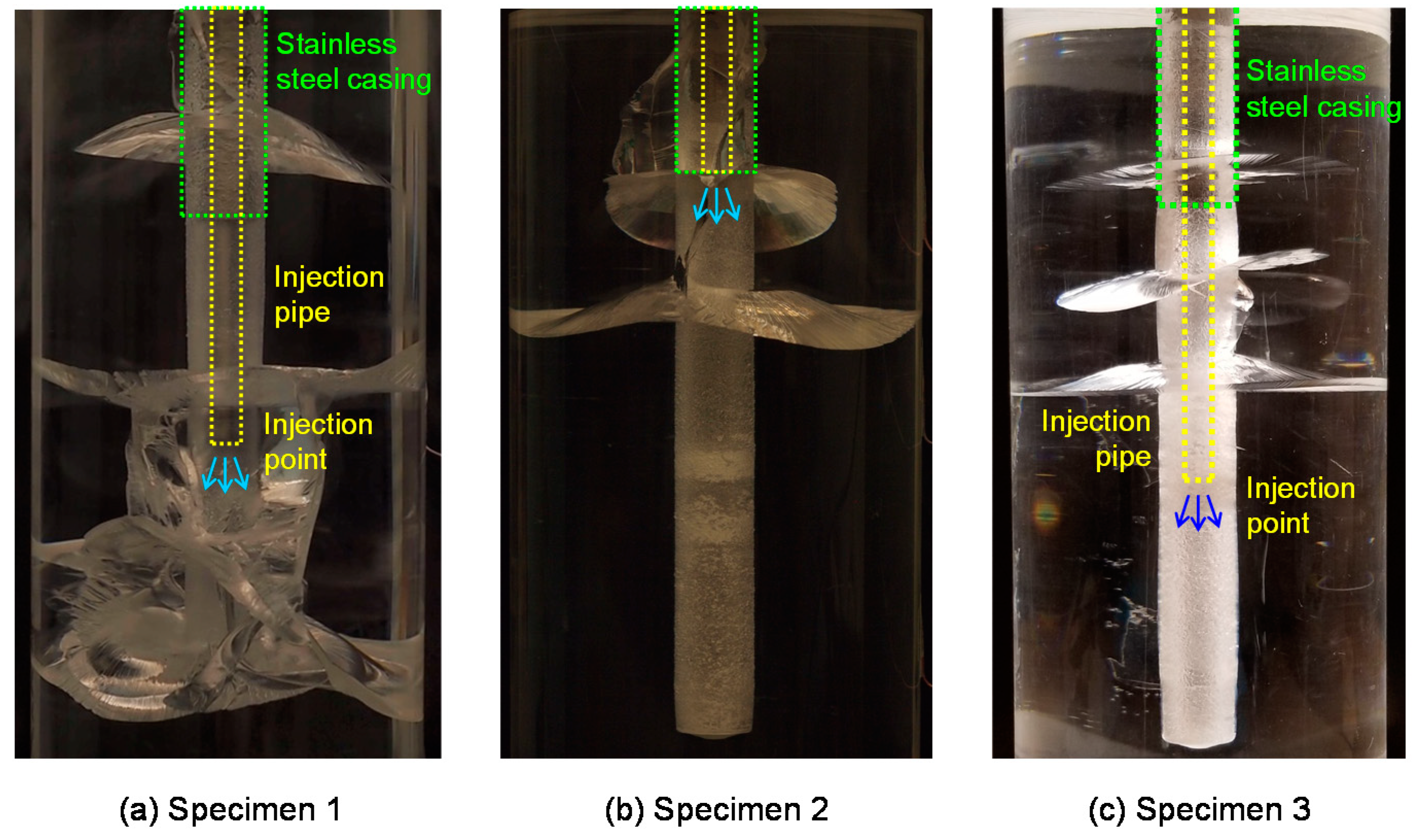
| Properties | PMMA (a) | PMMA (low-T) (b) | Niobrara Shale (c) |
| Density (g/cm3) | 1.18–1.19 | − | 2.39 |
| Unconfined compressive strength (MPa) | 90–120 | 250 (−40 °C) | 54.6 |
| Tensile strength (MPa) | 55–76 | 100–110 (−40 °C) | 8.48 (Splitting) |
| Static Young’s modulus (GPa) | 2.4–3.3 | 5.1 (−173 °C) | 41.4 |
| Poisson’s ratio | 0.35–0.4 | - | 0.27 |
| Specific heat capacity (J/(kg·K)) | 1450 | 450 (−196 °C) | 990 |
| Thermal conductivity (W/(m·K)) | 0.18–0.19 | 0.14 (−196 °C) | |
| Linear thermal expansion coeff. (K−1) | (60–80) × 10−6 | 26 × 10−6 (−196 °C) | 11 × 10–6 |
| Liquid Nitrogen (d) | Gas Nitrogen (e) | Water (e) | |
| Viscosity (cP) | 0.158 | 1.76 × 10−2 | 1.002 |
| Density (g/mL) | 0.807 | 0.0012 | 0.998 |
| Surface tension (dyn/cm)(against air) | 8.85 | − | 72.8 |
| Specific heat (kJ/(kg∙K)) | 2.04 | 1.04 | 4.18 |
| Thermal conductivity (W/(m∙K)) | 0.140 | 0.025 | 0.591 |
Publisher’s Note: MDPI stays neutral with regard to jurisdictional claims in published maps and institutional affiliations. |
© 2021 by the authors. Licensee MDPI, Basel, Switzerland. This article is an open access article distributed under the terms and conditions of the Creative Commons Attribution (CC BY) license (https://creativecommons.org/licenses/by/4.0/).
Share and Cite
Cha, M.; Alqahtani, N.B.; Yin, X.; Wang, L.; Yao, B.; Kneafsey, T.J.; Miskimins, J.L.; Wu, Y.-S. Propagation of Cryogenic Thermal Fractures from Unconfined PMMA Boreholes. Energies 2021, 14, 5433. https://doi.org/10.3390/en14175433
Cha M, Alqahtani NB, Yin X, Wang L, Yao B, Kneafsey TJ, Miskimins JL, Wu Y-S. Propagation of Cryogenic Thermal Fractures from Unconfined PMMA Boreholes. Energies. 2021; 14(17):5433. https://doi.org/10.3390/en14175433
Chicago/Turabian StyleCha, Minsu, Naif B. Alqahtani, Xiaolong Yin, Lei Wang, Bowen Yao, Timothy J. Kneafsey, Jennifer L. Miskimins, and Yu-Shu Wu. 2021. "Propagation of Cryogenic Thermal Fractures from Unconfined PMMA Boreholes" Energies 14, no. 17: 5433. https://doi.org/10.3390/en14175433
APA StyleCha, M., Alqahtani, N. B., Yin, X., Wang, L., Yao, B., Kneafsey, T. J., Miskimins, J. L., & Wu, Y.-S. (2021). Propagation of Cryogenic Thermal Fractures from Unconfined PMMA Boreholes. Energies, 14(17), 5433. https://doi.org/10.3390/en14175433






